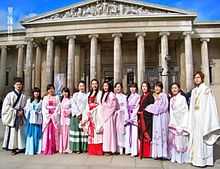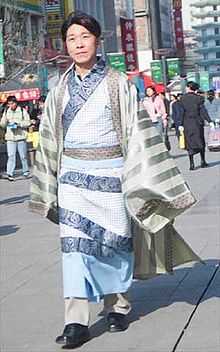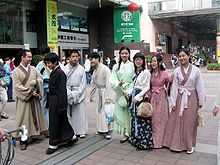Hanfu movement

Hanfu movement (simplified Chinese: 汉服运动; traditional Chinese: 漢服運動), or the Hanfu subculture, is a movement created in China to reintroduce into modern life the ancient Han Chinese clothing styles before Chinese Qing Dynasty (1644–1912).
History

According to Asia Times Online, the Hanfu movement may have begun since around 2003, when a man called Wang Letian from Zhengzhou, China publicly wore Hanfu.[1] Wang and his followers inspired others to reflect on the cultural identity of Han Chinese, and the Hanfu movement was born as an initiative to revive and preserve the Han identity. The Hanfu movement has been controversial since its initiation. While supporters often applaud its reviving of Han culture, some others criticize its cultural exclusiveness. The Han Chinese society as a whole has not accepted Hanfu as a type of traditional clothing. People who wear Hanfu in public are often considered eccentric.
Hanfu enthusiasts often hold events that encourage the public to wear Hanfu. Major events in recently years include Guan Li's and Ji Li's (Chinese coming of age ceremonies). Hanfu can also been seen every year in numerous public and private ceremonies.
Debates
Debates surrounding Hanfu mainly concern about the legitimacy and the cultural implications of Hanfu.
The exact definition of "Hanfu"
Throughout China's long history, the clothing of the Han people has undergone many changes. The costumes of each dynasty is different, reflecting the values and interests of each period. It was not until the Qing Dynasty that the Hanfu became forcibly replaced by the costume of Manchu. Though many believe the Qipao or Cheongsam is China's national costume, this is relatively inaccurate as, considering China's thousands of years of history, the qipao is fairly modern. [2]
To revive or not to revive
Some people believe that the disappearance of the Hanfu is not abnormal. Nowadays, many feel that the Hanfu is no longer relevant or convenient, and has been consigned to China's historical culture.
There are those who believe that every ethnic group's costume is important and a valuable development and piece of the past, embodying the culture and traditions of that group. Hanfu is the traditional costume of the Han Chinese, so it is representative of the nation's traditional culture. The Chinese people are becoming more aware of this connection between themselves and their ancient culture. The practice of wearing Hanfu has also had the benefit of development and propagation of the traditional culture of China.
Complete restoration?

Some think it is important for certain occasions. One can wear Hanfu for holidays, festivals, weddings, birth parties, funerals or even as regular clothing. Those who believe that wearing Hanfu is inconvenient can continue wearing modern clothing. There are also those who believe that national costumes can become the standard ideal of clothing for special occasions and holidays. Example of this include Japan (kimono) and Korea (Hanbok or Chosŏn-ot) where their national costumes do not completely dominate everyday clothing, yet make appearances during national festivals. Some even suggest modifying Hanfu to make it more appropriate for everyday clothing. As the predecessor of the kimono, the Hanfu is surprisingly unknown to the rest of the world.
But like many other national costumes, Hanfu has a formal, more heavy and elaborate form for certain occasions (like the Western white tie or tuxedo), and an informal, light and easy to wear form which is more convenient to wear everyday. So completely reviving Hanfu is not as inconvenient as any other national costume.
However, there may be practical concern for complete Hanfu restoration. In parts of Han dynasty, the pants people wear (if any) did not cover the crotch, so sitting with splitting legs would be regarded as extremely rude.[3]
Whether the Tangzhuang can fully represent the Han nationality
Some believe that the Tangzhuang (i.e. Qipao and Cheongsam) has had a tremendous influence overseas and that many foreigners recognise them as the de facto Chinese costume and that Hanfu does not share the same influence or recognition in today's environment.
Criticism
Many Hanfu advocates argue that making Hanfu a national dress could unite the country, creating a cultural symbol for the country and creating a tradition for future generations.[4] However, critics of the movement fear that the revival leans too far in the direction of a narrow nationalism, focused on looks rather than content.[5] They fear that a blanket dismissal of non-Hanfu dress could lead a step further, towards a rejection of the West that goes beyond clothing matters.
While many Hanfu enthusiasts advocate Hanfu as a national dress, critics see this as an internal problem, as Hanfu is the traditional dress of the Han people. Hanfu as a national dress would fail to represent the other 55 ethnicities of China.[6]
Historical relevance
Many feel that Hanfu is out-dated and old fashioned. A similar example is why people in the West do not wear period costume (British people do not wear costumes of Elizabethan times in everyday life) and since Hanfu is theoretically a 'period costume', it is unsuitable for wear in a modern progressive society. However, since it has been worn for the majority of Chinese history, it would not be considered a "period costume." In fact, the use of the Qipao is relatively recent, and would classify as a period costume.
The sudden change in Chinese clothing from traditional Han-style to strong Manchurian and Western influences has caused confusion as to the idea of what China's national costume is. Hanfu's development halted in the 17th century due to government sanctions by the Manchurian Qing government, so the Hanfu has been placed in a situation that other national costumes have had the fortune not to experience. Technically, Hanfu is a costume lost not through natural development, but through forced change.
There is also debate as to whether Hanfu is just a fashion-fad or a form of Romantic nostalgia for the past, rather than anything of modern relevance.
Recent developments
In February 2007, a proposal to use Hanfu for the official clothing of for the Chinese 2008 Summer Olympics was submitted to the Chinese Olympic Committee.[7] After considering the proposal and debating on what should be the official clothing, the Chinese Olympic Committee rejected the proposal in April.[8]
In 2008, the Chinese Central Government's official Web portal used a portrait of a woman in Hanfu to represent the Han ethnicity on the introductory page of the fifty-six ethnic groups.[9]
| Wikimedia Commons has media related to Hanfu movement. |
See also
Notes
- ↑ Asian Times Online: Han follow suit in cultural renaissance
- ↑ "Chinese Clothing - Five Thousand Years' History". Culture Essentials Explore Chinese Culture. Retrieved 12/07/2011. Check date values in:
|accessdate=(help) - ↑ 奥运汉服下面有没有底裤?
- ↑ Beijing Review : Should China Adopt Hanfu as Its National Costume?
- ↑ Beijing Review : Should China Adopt Hanfu as Its National Costume?
- ↑ Beijing Review : Should China Adopt Hanfu as Its National Costume?
- ↑ Phoenix TV: Submission for a Proposal on Hanfu dress for the 2008 Chinese Olympics to the China Olympics Committee (Chinese)
- ↑ 官方首次表态北京奥运礼服不用汉服 (Chinese)
- ↑ 中国56个民族 (Chinese)
External links
- Hanfu Review An English Blog with Hanfu movement news archive
- Hanfu Union (Chinese)
- The Han Net (Chinese)
- HanFu Promotional Association(Chinese)
- Toronto Association for the Revival of Hanfu (Chinese)
- 開講天下 Television debate on whether the Western suit, Tangzhuang or Hanfu is to be appropriate for the Chinese Olympics. part 1, part 2, part 3 (Chinese)
- The Great Movement of Restoring Authentic Chinese Clothing
- 2006年中國政府 正式認可漢服是漢民族的傳統民族服裝—的始末(Chinese)
- “唐裝, 旗袍”的歷史引發中國民間 第二次保衛漢服運動(Chinese)
- 漢民族在國內的尊嚴:什麼時候起,你察覺到漢民族因沒有了民族服飾而 喪失民族尊嚴的尷尬?(Chinese)
- 比較亞洲禮儀小姐先生和外交的 服飾文化(Chinese)